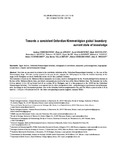Towards a consistent Oxfordian–Kimmeridgian global boundary: current state of knowledge
| dc.contributor.author | Wierzbowski, A | |
| dc.contributor.author | Atrops, F | |
| dc.contributor.author | Grabowski, J | |
| dc.contributor.author | Hounslow, M | |
| dc.contributor.author | Matyja, BA | |
| dc.contributor.author | Oloriz, F | |
| dc.contributor.author | Page, K | |
| dc.contributor.author | Parent, H | |
| dc.contributor.author | Rogov, MA | |
| dc.contributor.author | Schweigert, G | |
| dc.contributor.author | Villasenor, AB | |
| dc.contributor.author | Wierzbowski, H | |
| dc.contributor.author | Wright, JK | |
| dc.date.accessioned | 2016-06-30T10:34:45Z | |
| dc.date.available | 2016-06-30T10:34:45Z | |
| dc.date.issued | 2016-04-30 | |
| dc.identifier.uri | http://hdl.handle.net/10026.1/4996 | |
| dc.description.abstract |
New data are presented in relation to the worldwide definition of the Oxfordian/Kimmeridgian boundary, i.e. the base of the Kimmeridgian Stage. This data, mostly acquired in the past decade, supports the 2006 proposal to make the uniform boundary of the stages in the Flodigarry section at Staffin Bay on the Isle of Skye, northern Scotland. This boundary is based on the Subboreal-Boreal ammonite successions, and it is distinguished by the Pictonia flodigarriensis horizon at the base of the Subboreal Baylei Zone, and which corresponds precisely to the base of the Boreal Bauhini Zone. The boundary lies in the 0.16 m interval (1.24–1.08 m) below bed 36 in sections F6 at Flodigarry and it is thus proposed as the GSSP for the Oxfordian/Kimmeridgian boundary. This boundary is recognized also by other stratigraphical data – palaeontological, geochemical and palaeomagnetic (including its well documented position close to the boundary between magnetozones F3n, and F3r which is placed in the 0.20 m interval – 1.28 m to 1.48 m below bed 36 – the latter corresponding to marine magnetic anomaly M26r).The boundary is clearly recognizable also in other sections of the Subboreal and Boreal areas discussed in the study, including southern England, Pomerania and the Peri-Baltic Syneclise, Russian Platform, Northern Central Siberia, Franz-Josef Land, Barents Sea and Norwegian Sea. It can be recognized also in the Submediterranean-Mediterranean areas of Europe and Asia where it correlates with the boundary between the Hypselum and the Bimmamatum ammonite zones. The changes in ammonite faunas at the boundary of these ammonite zones – mostly of ammonites of the families Aspidoceratidae and Oppeliidae – also enables the recognition of the boundary in the Tethyan and Indo-Pacific areas – such as the central part of the Americas (Cuba, Mexico), southern America, and southern parts of Asia. The climatic and environmental changes near to the Oxfordian/Kimmeridgian boundary discussed in the study relate mostly to the European areas. They show that very unstable environments at the end of the Oxfordian were subsequently replaced by more stable conditions representing a generally warming trend during the earliest Kimmeridgian. The definition of the boundary between the Oxfordian and Kimmeridgian as given in this study results in its wide correlation potential and means that it can be recognized in the different marine successions of the World. | |
| dc.language.iso | en | |
| dc.title | Towards a consistent Oxfordian–Kimmeridgian global boundary: current state of knowledge | |
| dc.type | journal-article | |
| plymouth.journal | Volumina Jurassica | |
| dc.identifier.doi | 10.5604/17313708.1201736 | |
| plymouth.organisational-group | /Plymouth | |
| plymouth.organisational-group | /Plymouth/Faculty of Science and Engineering | |
| plymouth.organisational-group | /Plymouth/Faculty of Science and Engineering/School of Geography, Earth and Environmental Sciences | |
| plymouth.organisational-group | /Plymouth/REF 2021 Researchers by UoA | |
| plymouth.organisational-group | /Plymouth/REF 2021 Researchers by UoA/UoA07 Earth Systems and Environmental Sciences | |
| dcterms.dateAccepted | 2016-02-11 | |
| dc.rights.embargoperiod | Not known | |
| rioxxterms.versionofrecord | 10.5604/17313708.1201736 | |
| rioxxterms.licenseref.uri | http://www.rioxx.net/licenses/all-rights-reserved | |
| rioxxterms.licenseref.startdate | 2016-04-30 | |
| rioxxterms.type | Journal Article/Review |


